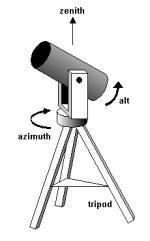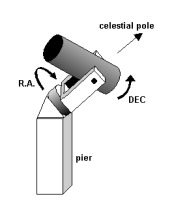Fork Mounts
The fork mount, although already in use for a long time in professional astronomy, is becoming more and more popular with the amateur astronomer because it offers fantastic solidity with some great extra benefits for those with larger telescopes.
The mount can be used in both alt-azimuth and equatorial set-ups. In the first instance, the axis that turns the fork holding the telescope is pointed to the zenith. In an equatorial set-up, the same mount is tilted so that the fork axis points to the celestial pole.

Due to the lack of a counterweight, using a fork mount in equatorial mode on a tripod is usually accomplished by the addition of a heavy metal plate, positioned off-centre to maintain the stability of the scope. The slope of this plate is adjustable to enable correct polar alignment. To overcome the problems of tracking celestial objects, most modern fork mounts are fitted with electric motors connected to a microprocessor. This processor calculates the current position of the object in relation to the time and activates the motors to keep it in view.These scopes are referred to as Go-To types and have the further advantage of a library of thousands of celestial objects stored in software. Provided the object is visible, the scope can locate and track it.

If you want to take long exposure photographs, it is even possible to overcome the problem of ‘field rotation’ by slowly turning the camera with the field using yet another electric motor, connected to the same processor. The latter system is known as a field de-rotator.
Needless to say that such computerised alt-azimuth fork mounts are expensive but costs are slowly declining as sales and competition between manufacturers increase.